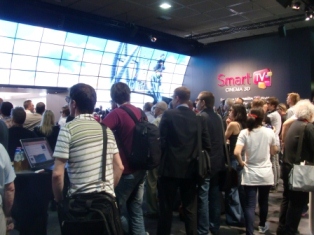
Last week, I wrote about the IFA Berlin tech trade show, which was just getting underway. I'll have a more extensive column soon about the full, maniacal zoo-like extravagalooza, but in the interim I thought it might be nice to take a quiet step back and address just one prominent area there.
To be clear, IFA Berlin is massive. It's spread over 27 buildings - some of them even possible to find without a personal GPS. (Seriously. One afternoon I wanted to go to Hall 3, second floor. It took me over 20 minutes to find it. And at one point, I was even in Hall 3. It took 10 minutes to figure out how to get to the second floor.)
But once you found what you were looking for, you were surrounded by an abundance of it. "It" being anything that requires electricity. The Consumer Electronics Show in Las Vegas is about trends. IFA Berlin (which has been around for nearly 75 years, beginning with radio) is about innovation.
Some innovation makes it. Some doesn't. And some serves as the inspiration for other directions. That's why innovation is so utterly fascinating to watch.
Which brings us to 3D-TV.
Long ago, I gave up writing about televisions at trade shows. You walk into an exhibit of TVs, and it's terrifying, like having an ocean swallow you. They all explain why they're better than the next guy, and the techno-babble is enough to make your head explode. A single company may have 50 different models. The reality is that even the most moderate among them provides a very good picture these days.
But writing about 3D-TV is another matter entirely because we're not just talking models, but the technology. And it's a potential industry-changer. Behemoths like Panasonic, Samsung, LG, Sony, Toshiba and on and on are all heavily pushing 3D-TV. And have been pushing it hard for the past several years. It's everywhere at trade shows, and it's in your face (almost literally...)
Returning from IFA Berlin, a friend asked me about the technology, because he was involved with a new TV project, and they were considering the viability of producing it in 3D. Before getting to his specific questions about 3D-TV, though, I said that there's another matter first.
To begin with, 3D-TV looks absolutely terrific. Vibrant, crisp, rich. The technology works great. However, since I first saw it, I've had serious, practical questions about whether it will succeed. Because companies are making such a huge push for 3D-TV, maybe their forceful efforts will win the day, but I've spoken with a bunch of other tech writers (far more techie than I am), and they agree with me. Here are some of the big, "real world" issues I see with 3D-TV -
There is no standard with glasses. "Active shutter" can cost up to $100, and require charging. "Passive" are significantly less expensive, but have greater resolution issues (though they do look extremely good). And even within either format, there is no standard. One brand isn't compatible with another.
More to the point, if you have friends over to watch television, you likely won't have enough glasses for everyone. That's just if you invite a few friends. But what if you plan to have a Super Bowl party - who is going to have 30-40 pairs of glasses sitting around? Any TV technology that risks being unusable on Super Bowl Sunday parties is starting from a deep hole.
(A friend recently told me that her mother bought a 3D-TV set for a Super Bowl party last year, and afterwards her mother said it was the worst purchase of her life. She only had a few sets of glasses, and the rest of the people stood there watching a blurry TV screen.)
Then there's the issue of content. It's painfully limited right now, and most available content isn't TV, but movies. And even when it exists, will people even care enough about watching it in 3D? Sports might be nice, but that's a small starting point for a new technology. (Maybe the Kardashians, since that's what they seem to be promoting anyway.)
And let's say you do find some 3D content. You still run into the problematic reality of how people actually watch TV. They hold their remote and flip-flip-flip through channels. But when you flip from a 3D show to another channel that's in 2D, it'll look all fuzzy. Will commercials be in 3D? Or even if you stick with one show, will your eyes keep having to adjust from normal to fuzzy?
(Technology does exist for converting 2D content into 3D in real time, and many higher-end sets do that. But it's not as rich as natural 3D shot that way, and is more "layered" looking.)
Another practical problem is that two years ago, the public had to switch to digital TV sets, and many people bought a new TV. Most are not likely ready yet to make another big purchase - especially when it can cost $2,000, or up to $4,000.
Yet although those are basic questions, they're largely technical issues which potentially can be addressed in time. There's a far bigger problem, and it's a social matter, which is much harder to overcome. And that's - 3D is simply not how most people watch television. When people watch TV, they go to the bathroom, go to the kitchen, talk on the phone, play on their iPad, chat with others in the room, switch channels, read books and more. That's exceedingly difficult while wearing 3D glasses. And it's a challenge the 3D-TV industry will have to figure how to overcome.
(At IFA Berlin, a couple of journalists in my group said they were given a 3D-TV for free...and they almost never watch it.)
None of this is to say that there isn't a future for 3D-TV. In fact, there's a very big one. It exists for watching movies and for playing interactive games. Large TV screens work particularly well for these sort of content. Further, the market also exists in a big way for computers, where 3D quality on monitors is extremely good, and it's a more personal experience.
In all fairness, I could be totally wrong about this. Maybe the huge promotional push will win the day. But my qualms aren't a case of not liking some new-fangled technology. I actually do like it. It looks absolutely great. The LG exhibit for 3D-TV was spectacular, the sort of thing where you keep ducking because you're sure that a space ship is going to crash into you. My questions are more of a "real world" nature, wondering if the technology fits into how people actually live their lives.
But there's an "on the other hand."
On the other hand, 3D without glasses is how people do watch TV, and it's making good strides - but that's still quite a few years away. (Sort of.) The big guys aren't ready yet. Toshiba does have a glassless 3D set coming out, but the viewing range is severely limited, the 3D pop is small, and it's very expensive.
The reason I said "sort of" above is because for the past couple of years I've been writing about a tiny company based in Philadelphia, Stream TV Networks- and inexplicably (or miraculously) they've blown away the big guys with their "Ultra-D" technology. It was actually workable two years ago, and last year they were already demonstrating it with Harry Potter, and now they've signed two manufacturing deals: with Hisense (one of the biggest TV manufacturers in China) and Pegatron (who builds the Apple iPhone, among other products). The company now says they should be selling them "within months," maybe 3-6. (Though that likely will be in China first, not the U.S.) And the cost with be "consumer oriented." The larger point though is that when tech writers say that glassless 3D isn't ready...that's just not true. I've seen it, and seen it for two years. And it's now coming to market.
And it looks good. It doesn't come close to looking as good as 3D-TV with glasses. But it's 3D and (most importantly) it's real-world usable, how you watch television. Having brilliant technology is one thing - having technology you can actually use is another.
Ultra-D's viewing angle is remarkably wide, so most everyone in a room can see the 3D. (The Big Guys competition require being in a very specific spot.) It also lets you adjust the 3D setting for personal preference - big "pop" but less-sharp image, or crisper image with less pop. And their SeeCube™ technology converts 2D show to 3D in real-time, with limited loss of quality.
The company made an additional announcement at IFA Berlin. The current standard for high-definition today is 1080p. (That's basically related to the number of pixels.) There is a new standard being developed called 4K. Incredibly high resolution. But at the moment, it's very expensive, and no native content is available for consumer sets. Whether it's worth the cost is also a question, though I've seen demonstrations, and it's stunning. Well, Stream TV Networks has developed a way to convert current 1080p resolution, to 4K.
All this from a tiny, unknown company. How they've leaped far past the monolith companies is stunning. In fact, when I was at their booth, executives from the big guy companies were coming over to talk with Stream TV Networks CEO, Mathu Rajan all day. (Either to figure out what in the world Stream TV Networks is doing, or perhaps to license their Ultra-D?)
I truly don't know how in the world Stream TV Networks leaped so far ahead of the giants. I've discussed it with the Rajan brothers (Raja is the COO), and the best explanation I can come up with is that while the others were working on 3D with glasses, Stream TV Networks ignored that entirely and put their R&D money and time into glassless. But it's still bizarre. What will happen next, who knows? But when you physically see in front of you what they've done, a really-working product, and you compare it impressively to others, and you see the other big companies coming to their booth, it's hard to ignore how remarkable it what they've done. They truly are David to Goliath, and the very little engine that could.
The only unfortunate thing writing about 3D is that you can't actually show what you're referencing. (The company has a little video about Ultra-D, but obviously it doesn't remotely do it justice.)
To be clear, just because Stream TV Networks has a technology that works and is coming to market, glassless 3D-TV still isn't imminent. There's a massive market that has to be saturated, and one small company can't do that alone. And it's still going to take time (and other companies competing) to saturate the TV market in a way that's meaningful.
And again, all this ruminating about 3D-TV with glasses and comparing it to glassless is just my opinion. (And that of the few, other tech journalists I've discussed this with.) But it's my perception based on real-world observation.
I think the manufacturers of 3D-TV with glasses want to believe it's an incipient trend, but honestly, I just don't see it, for all those real-world reasons mentioned above. And I'm not even sure if it will ever become a trend, whether or not glassless 3D-TV leaps past it - but most especially if it does.
Back in January, 2011, I wrote, "There was a story during CES how vendors were surprised that 3D-TV sales hadn't been strong in 2010, attributing it to wishful, minor causes. But I think they're missing the larger point, and I found agreement among those I talked to. To be clear, the technology is seriously impressive. But briefly, the problem are these:"
Another 18 months have passed, and that reality remains. Will 3D-TV with glasses make it? Will glassless 3D? Or, the way technology speeds by so fast, will something else even more impressive get developed instead?
We'll just have to see. In 3D...



